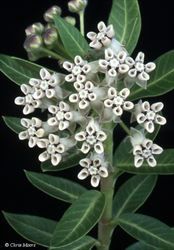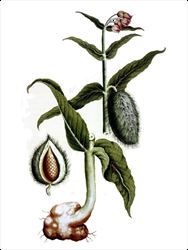Click on images to enlarge

Photo by Chris Moore.

By Hendrik Claudius (c1655-c1697), apothecary visited Cape to draw plants later copied for inclusion in Nicolaas Witsen's (1641-1717) Codex Witsenii [Public domain], via Wikimedia Commons
Scientific Name
Gomphocarpus cancellatus (Burm. f.) Bruyns
Synonyms
Asclepias arborescens L.Asclepias cancellata Burm. f.Asclepias rotundifolia Mill.Gomphocarpus arborescens (L.) R. Br.
Family
Asclepiadaceae (Victoria, the ACT, Tasmania, South Australia, Western Australia and the Northern Territory)Apocynaceae (Queensland and New South Wales)
Common Names
broad leaved cotton bush, broad leaved cottonbush, broad-leaf cotton bush, broadleaf cotton bush, broad-leaf cotton-bush, broad-leaved cotton bush, broad-leaved cotton-bush, cotton bush
Origin
Native to south-western Africa (i.e. western South Africa and southern Namibia).
Naturalised Distribution
Naturalised in south-eastern Australia (i.e. in south-eastern and eastern South Australia and southern and western Victoria).
Notes
Broad-leaved cotton bush (Gomphocarpus cancellatus) is an environmental weed in South Australia. This species, which is the larval food plant of the wanderer butterfly (Danaus plexippus), has been cultivated as a garden ornamental in the temperate regions of Australia. It has escaped cultivation and is now a common environmental weed of the Adelaide region.
Broad-leaved cotton bush (Gomphocarpus cancellatus) is mainly a weed of waste places, but has also invaded numerous conservation areas in south-eastern South Australia (e.g. Marino Conservation Park, Cleland Conservation Park, Cobbler Creek Recreation Park, Horsnell Gully Conservation Park, Coorong National Park, Onkaparinga River National Park, Anstey Hill Recreation Park and Little Mount Crawford Native Forest Reserve). In fact, it is regarded as a considerable management problem in Morialta Conservation Park and as a high priority weed species in the Altona Creek CSR Landcare Reserve.

